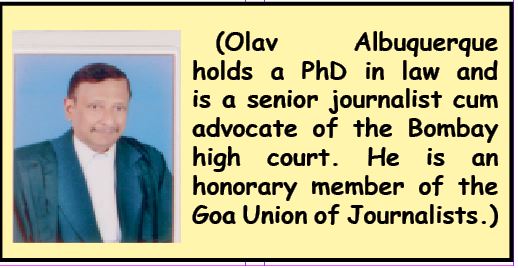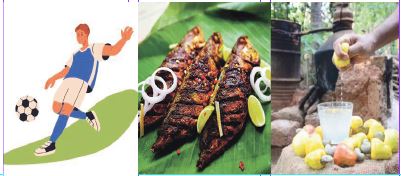FOOTBALL, fish and feni are the three staple diets of niz Goenkars not necessarily in that order. What is more interesting is though they may deny it, caste is an integral part of the Goan ethos. There are thousands of exceptions but conservative Goans rarely marry outside their caste. This is why football unites where religion divides. Whether you are a Chardo, Bamon, Sudra, Chamar or anything else, your dexterity with the ball or under the goalpost is more important than your caste.
It was Fr William Robert Lyons who introduced football to Goa in 1883 after he came to Siolim in Bardez taluka from Udupi in present-day Karnataka, to recuperate from poor health. Fr Lyons was a British missionary and contemporary records do not reveal what diseases he contracted from what must have been swampy areas in Udupi.
The portly “Choppy” was a nickname for the long-winded Francis Xavier Janim Ribeiro, whom I met during a Vipassanna retreat in Navi Mumbai, where he had come to recuperate mentally and spiritually after being beaten with tube lights and hockey sticks. He wrote a foreword for the “Grass is Green in Goa” which chronicled 40 years of the Goa Football Association.
CHOPPY DIED YOUNG
CHOPPY told me how he boarded the wrong train at Margao and would have been fined but for his press card which saved him that ignominy. As the former sports editor of oHeraldo, Choppy died at the young age of 57 on December 16, 2020 after a brief illness. Like another colleague, Ashley D’Mello, my late colleague in The Times of India, who also died, recently.
Marcus Mergulhao has recorded the history of the Salgaocar and Dempo sports clubs in two coffee table books, but left out fish and feni which also played a part in nurturing football talent during the monsoon in Goa.
To return to football, side-by-side with the 19th century kudds (dormitory style rooms or clubs named after Goan villages) in Jer Mahal, next to Metro cinema, football took early roots in every village because a football field was built adjacent to the village church, which housed baptismal and marriage records.
Dr Aida Dourado who did her PhD on these kudds, says the 250 kudds in the 1970s have dwindled to just 24 between the 2nd and 4th floors in Jer Mahal at Dhobi Talao, and it was in these kudds that budding footballers from Goa stayed while seeking jobs in Bombay.
After hearing Mass on Sunday mornings or evenings, the parish priests of these churches took out a football and encouraged the youth to have a game of football. Some of these parish priests were themselves adept footballers. They taught the youth the art of trapping the ball, dribbling, shooting and passing the ball to a teammate to score goals. The major seminaries of Rachol and Saligao produced some of these parish priests who were also footballers.
It was on the football field, that the youth forgot their ancestry and lineage, because whether you were Catao or Bosteao or Camilo or Brahmanand, it did not matter. The shootings when the goalkeeper was unable to parry a shot and the shouts when a goal was scored leveled all divisions observed elsewhere. During marriages or even funerals, these caste divisions borrowed from Hinduism seeped into Goan Catholicism, to segregate society like apartheid in South Africa.
CHRISTIAN GROUPS
A SCHOLAR like Ashok Kumar Mocherla wrote around the beginning of 1802, Christian groups took shape in Machilipatnam, Corangu (near Yanam), Vishakapatnam, Chiracole (Srikakulam) and Ganjam in what is known as modern Andhra Pradesh. These Christian groups were a dynamic mix of natives and Europeans just as in Goa, the mestes were the offspring of Portuguese soldiers and local Goan women.
There is no doubt that the local Goan women found these young Portuguese soldiers attractive with their sturdy bodies and fair complexions. Like the English youth who went to India to seek their fortunes because they came from impoverished families in England, or what would have been categorized as slightly above our modern slum dwellers, the mestes were a unique blend of Portuguese and Goan genetics. They were people of mixed European and local Goan ancestry.
It is these mestes along with the local Goan youth who took to football in a big way and excelled in this sport. I remember having a classmate in Don Bosco High School at Panjim called Ivo Miranda who was one such mestes. He was easily identifiable by his fair complexion as a mestes. Aggressive by nature, he was quite mischievous in class and good at football, although he did not make it big like other classmates such as Dionizio Trinidade or “Danush” (Daniel Colaco), the younger brother of Armando Colaco.
My father-in-law, Stephen Lino Cordeiro, called Sunny, who played for St Xavier’s College in Mumbai in the 1950s, remembers how Neville D’Souza was a star in both hockey and football. Cordeiro recalls how he (Stephen) missed an easy goal-scoring opportunity for the college, with the spectators abusing him for the missed chance, “but D’Souza put his arm around me and said better luck next time. Be focused.”
Both Sunny from Saligao and Neville D’Souza from Assagao have passed away into the great football field in the sky on March 16, 1980 and June 6, 2020 respectively to enjoy another game with spectators and linesmen who may sport wings instead of uniforms. But that is a tale for another day. They have left their genes to their grandchildren, Rachel and Antoine Cordeiro, while Neville’s brother Derek D’Souza donned the national colours and coached the Indian football team in 1992-93.
SO, with a peg of feni downed with salted parra fish and some prawn balchao or sorpotel, these footballers of yore can tell you their tales of prowess on the football field. Mergulhao will testify to that.

